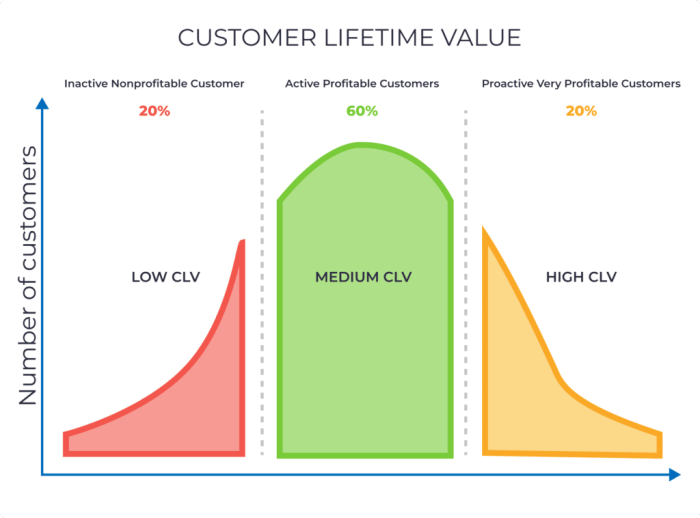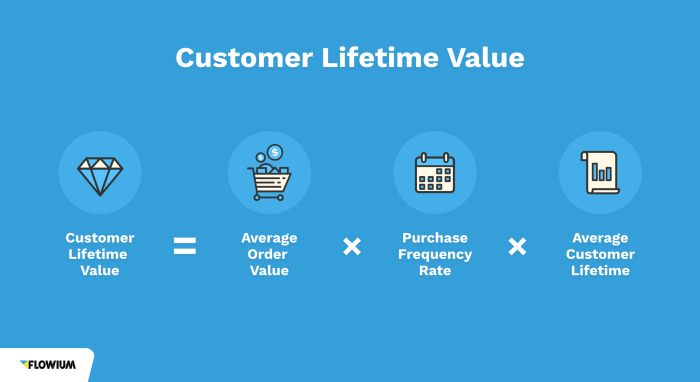Understanding Lifetime Customer Value is key to unlocking the secrets of customer loyalty and maximizing business success. Get ready to dive into the world of LCV with examples and strategies that will revolutionize your approach.
In this guide, we’ll explore the importance of LCV, factors influencing it, how to calculate it, strategies to improve it, and real-life case studies showcasing its impact.
Introduction to Lifetime Customer Value: Understanding Lifetime Customer Value
So, yo, let’s break it down – what’s this Lifetime Customer Value (LCV) all about? Well, LCV is basically the total revenue a business can expect to generate from a single customer over the entire duration of their relationship. It’s like knowing how much cash flow you can expect from your ride-or-die customers, ya feel?
Understanding LCV is crucial for businesses ’cause it helps them see the big picture and make smarter decisions. By knowing how much each customer is worth in the long run, companies can focus on building strong relationships, tailoring their marketing strategies, and offering top-notch customer service to keep those dollars rollin’ in.
Examples of LCV Impacting Business Decisions
- Companies can allocate their marketing budget more effectively by targeting high LCV customers with personalized campaigns that are more likely to convert.
- Businesses can invest in improving customer retention strategies to keep those loyal customers coming back for more, increasing their overall LCV.
- Understanding LCV can also help companies set pricing strategies that maximize profitability over the long term, taking into account the lifetime value of each customer.
Factors Influencing Lifetime Customer Value

In understanding Lifetime Customer Value (LCV), several factors come into play that influence how businesses calculate and maximize this important metric. Customer behavior, retention rates, purchasing frequency, and customer loyalty all play significant roles in determining the overall LCV for a business.
Customer Behavior
Customer behavior is a crucial factor that impacts LCV. Understanding how customers interact with your products or services, their preferences, and buying patterns can help businesses tailor their strategies to increase LCV. By analyzing customer behavior, businesses can identify opportunities to upsell, cross-sell, and personalize their offerings to maximize the value each customer brings over their lifetime.
Retention Rates
Retention rates refer to the percentage of customers that continue to do business with a company over time. High retention rates are directly correlated with higher LCV, as retaining existing customers is often more cost-effective than acquiring new ones. By focusing on customer satisfaction, providing excellent customer service, and implementing loyalty programs, businesses can improve their retention rates and ultimately increase LCV.
Purchasing Frequency
The frequency at which customers make purchases also plays a significant role in determining LCV. Customers who make frequent purchases are likely to have a higher LCV compared to those who make occasional purchases. By encouraging repeat purchases through targeted marketing campaigns, loyalty rewards, and promotions, businesses can boost purchasing frequency and subsequently increase LCV.
Customer Loyalty
Customer loyalty is a key driver of LCV. Loyal customers are more likely to make repeat purchases, refer others to the business, and have a higher lifetime value compared to one-time buyers. Building strong relationships with customers, providing exceptional customer experiences, and rewarding loyalty can help businesses cultivate a loyal customer base that contributes significantly to the overall LCV.
Calculating Lifetime Customer Value
When it comes to calculating Lifetime Customer Value (LCV), there are a few key formulas and methods that businesses can use to determine the long-term value of their customers. One common formula is:
LCV = Average Value of a Sale x Number of Repeat Transactions x Average Retention Time
This formula takes into account the average value of each sale, the number of times a customer makes a purchase, and how long the customer continues to do business with the company. By multiplying these factors together, businesses can get a rough estimate of how much each customer is worth over their lifetime.
Significance of Accurate Data in LCV Calculations
Accurate data is crucial when calculating LCV because the results directly impact the overall profitability and success of a business. If the data used in the calculations is inaccurate or incomplete, it can lead to misleading conclusions and ineffective strategies. By ensuring that the data inputted is precise and up-to-date, businesses can make informed decisions about marketing, customer acquisition, and retention efforts.
Using LCV Calculations to Optimize Marketing Strategies
Once a business has calculated the LCV of its customers, it can use this information to optimize its marketing strategies in several ways. For example, by identifying high LCV customers, businesses can tailor special promotions or loyalty programs to retain these valuable customers. On the other hand, by recognizing low LCV customers, companies can focus on improving their experience or encouraging them to increase their purchase frequency to boost their lifetime value.
Improving Lifetime Customer Value
Increasing Lifetime Customer Value (LCV) is crucial for the long-term success of a business. By implementing strategies to enhance LCV, companies can maximize their revenue and build strong relationships with customers.
Importance of Customer Satisfaction and Customer Experience
Customer satisfaction and experience play a significant role in improving LCV. Satisfied customers are more likely to make repeat purchases and recommend the brand to others, leading to increased revenue and loyalty.
- Provide exceptional customer service to address any issues or concerns promptly.
- Personalize interactions with customers to make them feel valued and appreciated.
- Collect feedback regularly to understand customer needs and preferences better.
Enhancing Customer Relationships
Building strong relationships with customers is essential for boosting LCV. By cultivating trust and loyalty, businesses can increase customer retention and lifetime value.
- Implement a loyalty program to reward repeat purchases and encourage customer engagement.
- Stay in touch with customers through personalized communication channels, such as email or social media.
- Offer exclusive deals and promotions to loyal customers to show appreciation for their continued support.
Case Studies on Lifetime Customer Value

Understanding how businesses effectively leverage Lifetime Customer Value (LCV) can provide valuable insights into strategic decision-making and long-term success. Let’s dive into some real-life examples of companies that have prioritized LCV in their business models.
Starbucks
Starbucks, a global coffee chain, is a prime example of a company that excels in utilizing Lifetime Customer Value. By offering a loyalty program that rewards frequent customers with free drinks and personalized offers, Starbucks has managed to increase customer retention and boost overall sales. This approach not only enhances customer loyalty but also helps Starbucks gather valuable data for targeted marketing campaigns.
Amazon
Amazon, the e-commerce giant, is known for its strategic use of LCV in decision-making. Through personalized recommendations, customized shopping experiences, and efficient customer service, Amazon has built a loyal customer base that continues to drive its growth. By analyzing customer behavior and purchase patterns, Amazon can optimize its offerings and enhance customer satisfaction, ultimately increasing Lifetime Customer Value.
Netflix, Understanding Lifetime Customer Value
Netflix, a leading streaming service provider, has revolutionized the entertainment industry by focusing on LCV. By investing in original content, improving user experience, and leveraging data analytics to understand viewer preferences, Netflix has successfully retained subscribers and attracted new ones. This customer-centric approach has not only increased revenue but also positioned Netflix as a key player in the digital streaming market.





